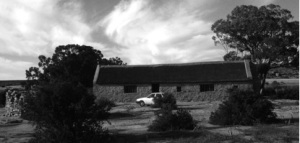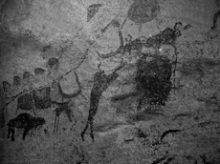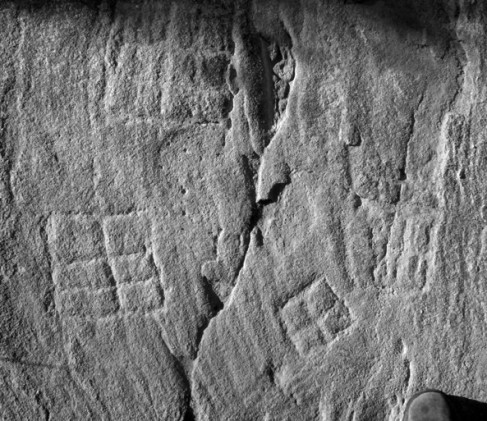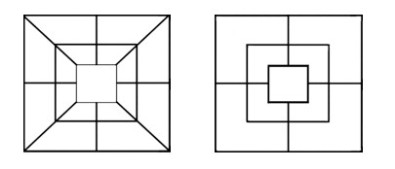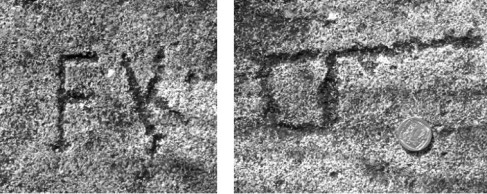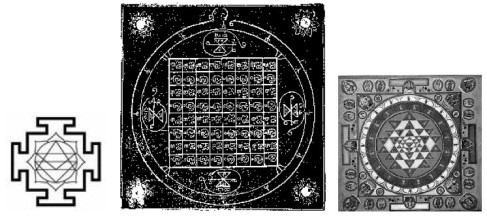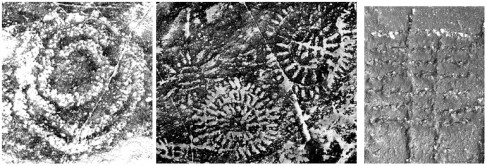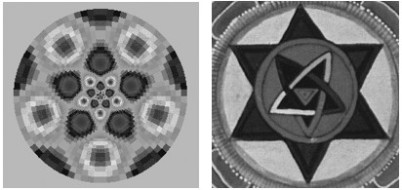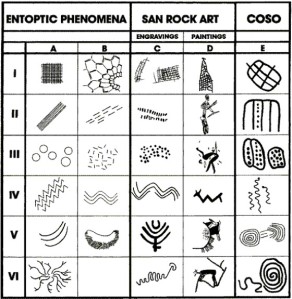Fig. 1
In the Spring of 2005 our family stayed in the restored bywonerhuis which stands among the forlorn ruins of the De Hoop farmstead on the farm Papkuilsfontein, thirty kilometres south of Nieuwoudtsville (Fig. 1).[i] We had been coming there for years, to enjoy the unparalled manifestation of the spring flowers, multitude on multitude in all their splendour and diversity, but also to escape the city, to walk in a landscape which one can imagine to be devoid of human activity, breathe unpolluted air, and enjoy the open-hearted hospitality of the farmers, the van Wyks.
My initial appreciation of the land as unpeopled, or relatively so, was undermined over successive visits as we began to notice the dense and layered signs of earlier habitation. The ruins of the farmstead, an assortment of structures of different ages and materials the last of which was abandoned in the 1930’s, stretch back in time towards the Battle of Oorlogskloof, when, in 1739, the Khoekhoen pastoralists who had inhabited the region were cornered in the kloof and systematically slaughtered by the Dutch, who then proceeded to occupy the region. At De Hoop they found a large level slab of Table Mountain Sandstone nestling against a sheltering outcrop a few hundred metres from a perennial source – the spring from which Papkuilsfontein derives its name. Here they could literally build upon the rock.
They were not the first to appreciate the virtues of the site at De Hoop and its immediate environs. From what I have seen, humans have been there since at least the Middle Stone Age, perhaps two to four hundred thousand years ago, and probably for as long as there have been humans. The landscape and ecology are particularly suitable to a foraging lifestyle – an abundance of bulbs (Nieuwoudtsville styles itself ‘The Bulb Capital of the World’) and of small game (the area is also known as the Bokveld) combined with an intersection of eco-systems allowed by the increased precipitation that the escarpment provides, (the fynbos, Karroo and Namaqualand ecologies meet and blend here,) all meant that the necessities of human life – food, water and shelter – were well-provided.
On our first visit, the farmer’s wife Mariette van Wyk, showed us a fairly well-known but mysterious example of rock art, situated a twenty-minute stroll from the cottage.
Fig. 2
The painting (Fig. 2) shows bags and theriomorphs, suggesting a world where a person could sprout wings, transform into a dark and shambling beast or disappear into a black hole in the rock. Over successive visits, we saw and even ‘discovered’ elsewhere on the farm many more paintings in various of states of preservation. What intrigued me was the variety and diversity of styles which they represented.
Fig. 3 Fig. 4 Fig. 5 Fig. 6
Fig. 7 Fig. 8 Fig. 9 Fig. 10
It was almost as though the paintings were somehow mimicking the rich diversity of the living things around them, for they do not seem to come from the same hand, or indeed from the same sensibility, so that I speculated that the area was not only an intersection of ecological systems but, because groups necessarily specialised in exploiting one or other ecology, an intersection of societies, or of lifestyles and artistic modes. The paintings are in the styles sometimes associated with the San (Figs 4, 6, 8 & 9) and the Khoekhoen (Figs 3, 5, 7 & 10) as well as a style which is not obviously either, where rough figures without the naturalism and finesse associated with San artists have nevertheless been painted with a brush or some other fine implement (Fig. 11). Further, within each recognisable style there is a variety of expression, skill and subject-matter. Some finger-paintings are patterned and deliberate, others seem hasty, as though done for phatic or ritual rather than aesthetic reasons. The brush-paintings also vary in quality, style and subject-matter, though what precisely the subject matter may be is at times difficult or perhaps impossible to make out. So it was that our perceptions of the place changed, and we came to see that the area held a rich history of culture, representing many different human practices over very long periods of time, and hinting at the mobility and fluidity of societies in pre-colonial times.
On an early spring morning in 2005 I went out of the back door of the cottage with a cup of coffee in my hand. The angled light exaggerated the wave-patterns on the lightly-rippled surface of the stone slab – remnants of an ancient ocean shore or river delta – so that the stone itself could easily be imagined as fluid, consisting of standing-waves, pools, rivulets and eddies in the unimaginably vast flow of time.
It was the light that revealed them, for there at my feet, just outside the back of the bywonerhuis, where I had stood many times before, I noticed for the first time a set of grids pecked into the stone (Fig. 12).
Fig. 12
What were these markings, I wondered, for they were clearly human-made and not the product of some bizarre disturbance of the ancient ocean’s flow. Who had made them, and for what purpose? Their shape immediately called to mind the image of windows or gates, so that I imagined that they could become metaphoric portals into a past quite different from the present dispensation. At first the obvious conclusion leapt to mind. They were pre-colonial rock art, pecked petroglyphs like the grids at Nooitgedacht glacial pavement or elsewhere in the interior. I use the term ‘petroglyph’ rather than ‘engraving’ because, for me as a jeweller, ‘engraving’ has a precise technical meaning that does not apply to these patterns.
Only later did I consider other hypotheses, and began to prod the grids with the five W’s of journalism, (actually six questions: who? what? when? where?, why? and how?) which are supposed to be the necessary foundation of a well-rounded story. In this essay, in order to explore the meaning of the petroglyphs, I shall ask who might have done them, what they are and how they may have been made (including an enquiry into what ‘entoptic’ might mean and an excursion into doodles), where they are, when they might have arisen, and finally make some guesses about their purpose – why they were made.
Who?
As soon as I asked who could possibly have made these grids, a host of overlapping possibilities presented themselves:
- Perhaps they were pecked out by the slaves or servants, bywoners etc. of the new colonists, some of whom, especially women and children, were captured people from the district?
- Perhaps they were made by colonist farmers or their servants or slaves, to play some game or for some other inscrutable purpose?
- Were they a hoax, a rock-art Piltdown Man, perpetrated by an archaeologist or, worse, an ‘enthusiastic amateur’ with an axe to grind about the distribution of rock-art?
- Were they made by pre-colonial peoples, presumably the San or Khoekhoen or some blend of them, who manifestly inhabited the region?
The first thing that became clear is that we cannot know. The stone is silent. We can only come up with hypotheses and assign probabilities to them, with varying degrees of confidence. The world is busy getting on with the present, silting the petroglyphs up and weathering them away, and as the present is all that is presented to us, it is here that we must seek the past.
What do we know about the slaves and servants of the early colonists, and in the light of this knowledge, how likely does it seem that they made the grids? Documentation of these now mute peoples is scant. They did not write their own histories and the picture of them that emerges is from court records and the like, where their utter subjection becomes clear. They were, we are told, denied their language, religion and traditional culture, forced to embrace the religion and language of their masters, and to occupy only very limited and subservient roles in their new social order. History records that the penalties for transgression of the new rules were extremely harsh, and in a climate where unassimilated Khoekhoen and San bands were routinely hunted down, the Colonial Authorities, such as they were, routinely looked the other way, or even assisted when disobedient members of the subjugated were beaten to death or otherwise brutally punished. Here is Dia!kwain’s account of the treatment of one Ruyter by his master, Koos Struys, for a minor misdemeanour, told to Lucy Lloyd in January 1876, from the Bleek & Lloyd Archive:
Ruyter was brought up by white men, he died while he was with the white man. The Boer had been beating him about herding the sheep, that he had not herded the sheep well. Therefore the Boer was beating him with the strap which people tie under the oxen’s necks. That strap it was with which the Boer beat him, when the Boer bound him upon the wagon. […] when the Boer was unloosing him, he fainted. People were those who came to lift him because the Boer had beaten him to death. He said to the other people that the other people seemed to think he did not feel the pain that he felt, as if the Boer had beaten him to death. It did not seem as if he would live. […] the Boer not only beat him, but when the Boer was beating him, he trampled on him while he was beating him. […] This happened that beating was the one he died of (Lloyd Bleek Collection: http://lloydbleekcollection.cs.uct.ac.za/)
The speed and effectiveness of their assimilation into their new roles, and the cultural destruction thus wrought, is illustrated by what happened in the case of the descendants of Wilhelm Bleek and Lucy Lloyd’s informants. Within a generation their stories were all but forgotten, and within 100 years the /Xam language disappeared among them. Elsewhere some pockets of /Xam culture may have survived, but this is not elsewhere.
If we interpret the grids as being indeed similar to other grids further inland, as a part of Khoekhoen culture, or perhaps a part of rituals related to women’s coming of age ceremonies as David Morris has suggested (Morris 2002), among either the San or the Khoekhoen or both then, though it is possible, it seems unlikely that they were made by the newly captured or their immediate descendants. Replication studies have shown that one can make such petroglyphs fairly easily with rudimentary stone tools, and while one can imagine that someone, compelled by whatever longing, could have carved the grids when the master was absent, perhaps at church, it is hard to picture the associated rituals taking place under the intolerant eye of the farmer.
If the grids are taken to have no ritual significance, or not to relate to the petroglyphs further inland, then what could they be? Game boards come to mind because of chess, checkers and go, which are all played on grids. There is indeed a tradition of game-boards carved into wood or stone that extends over large areas of Africa, (but not the Hantam) called variously mancala, awale and so on, but there is no match between these and the De Hoop grids. Mancala boards have two or four (never three) rows of indentations into which seeds or stones are placed.
In 2004 Maarten van Hoek described in The Digging Stick what he calls petroglyphs on the farm Schaapplaats near Clarens in the eastern Free State, near the northern border of Lesotho (Van Hoek 2004: 5-7).
Fig. 13
They included quadrisected triangular forms and three mandala-like grids (Fig. 13) incised in a stone platform near a river, two of which resemble Nine Men’s Morris boards. Van Hoek writes that ‘the game – referred to as tsoro, marabarbara or mafuvha – is a variant of Nine Men’s Morris’, and further, that the farmer had assured him that a now-dead foreman had recounted playing the game on the grids as a child.
Fig. 14
Nine Men’s Morris, he writes, was introduced to Africa by missionaries. Tsoro, and mafuvha turn out to be different names for mancala, a game which only resembles Nine Men’s Morris inasmuch as it is a game, so we must explain the petroglyphs as boards for the missionary-introduced game, marabarbara (Van Hoek 2004). But we can also consider the idea that van Hoek’s informant was wrong, and that the three grids are examples of form constant patterns pecked out for whatever reasons.
The De Hoop grids are far too simple for any known European game, those with less than 9 squares being too simple for tic-tac-toe, and the grids with one and two squares being too simple for any game at all. My inclination is to assign a very low probability to the grids being game-boards, unless someone can find a convincing record of games being played on such grids elsewhere.
Perhaps the grids were made by the colonist farmers some time after 1739? We live in a gridded culture – everywhere the grid is evident, whether in the patterns of floor tiles, arithmetic paper, woven fabric, game boards, braai grills, windows, doors, gates, architecture in general, or indeed the maps and calendars which we use to locate and orient ourselves, all of which are dominated by the rectilinear. The pre-colonial peoples did not live in such a culture. Their world was dominated, at least visually, by the more chaotic forms of the natural world – the sinuous curves of landscape, plants and animals – and rectilinear forms were rare, occurring only in certain minerals, and, perhaps significantly, in the grass mats which they are known to weave, and which they used to construct shelters. Thus we can find any number of visual analogues to the grids in the culture of the colonists, and few in that of autochthonous people. Should this incline us to attribute the grids to the colonists? On the other side of the cottage there is a petroglyph that is indisputably made by colonists – the initials F. K. are carved into a smooth section of the rock( Fig. 15). In my fantasy, of course, the initials were carved by Kafka in an undocumented visit to the colonies, but we must set fantasy aside, and learn what we can by examining the initials themselves. The line of these initials is quite different from that of the grids, neat and sharp, indicating an iron or steel tool. The K is a bit eroded – cars drive here.
Fig. 15 Fig. 16
It looks to me as though the tool (or the workman?) started off sharper and was not as keen by the time that he was finishing the K. This is consistent with the use of an iron tool. By contrast, the single-square grid a few metres away (Fig. 16) has a rough line of the type we could expect if the pattern had been pecked out with a stone, as do the other grids. The visual appearance suggests that the technology used to make them was different.
Assuming that the grids were not made by pre-colonial peoples, there is the problem of explaining them – what purpose could they have served? Our picture of early Dutch colonist culture is fairly comprehensive, but does not appear to contain grids like these, carved on stone. Unless there exists elsewhere evidence of colonists making such grids, and using them for this or that, (as for example the initials have a clear function in inscribing a marker of personal identity on the landscape,) I am inclined to dismiss this as an explanation.
I also assign a very low probability to the idea that they could be a hoax – such a mild, unimaginative hoax they would be, benefiting nobody’s thesis, and causing at worst the tiniest of ripples in the archaeological pond – and left for me to ‘discover’ only by the co-incidence of my presence and the dawn light.
It is much simpler to assume that the patterns were made by individuals of the culture that made similar petroglyphs elsewhere in the interior, nearer Kimberley, and that made finger-paintings of a great many geometric motifs locally, including those on the farm, some only metres away.
If they are pre-colonial, then who did them? I am left with two alternatives: Khoekhoen pastoralists, or San foragers (or some overlap of these?). The region was used or inhabited by both, so it is difficult to say with certainty. The patterns may be signifiers of Khoekhoen identity, as Benjamin W. Smith and Sven Ouzman have proposed in ‘Taking Stock: Identifying Khoekhoen Herder Rock Art in Southern Africa,’ (2006), though ‘identity’ may have been a more blurry thing than the neat categories which they suggest, especially in the domain of shamanism which the form constants (see below) hint at. They may cross categories, for San shamans are known to have been consulted by Khoekhoen people. Or they may have been signs of a women’s art concerned with women’s rituals and separate from men’s art, within either the San or Khoekhoen groupings. Or…
What? (and how?)
The what? question seemed the easiest – the grids were right there, and I had photos (Figs. 17 – 21). So what are they? They are a set of four grouped rectilinear grid petroglyphs, and two isolated ones. There may be others under some of the recent structures on the stone table, but we’ll probably never know. They appear to have been made with a series of placed blows with a hard tool of the hammer and chisel variety. To my eye the groove thus formed was further smoothed, perhaps with a quartz scraper of the kind which abounds in the vicinity. The largest is perhaps 20cm across, the smallest about 9cm long.
Fig. 17 Fig. 18 Fig. 19 Fig. 20 Fig. 21
1 sq, 4 lines 2 sq , 5 lines 4 sq, 6 lines 6 sq, 7 lines 9 sq, 8 line
Fig. 22 Fig. 23 Fig. 24 Fig. 25 Fig. 26
The grids are of the kind often referred to as entoptic patterns in post-1987 archaeological literature, so it is tempting to class them as entoptic grids, and draw various prescribed conclusions from this classification.
But what are entoptic patterns? The first scientist to systematise the study of artefacts of vision not derived from the world beyond the eyeball was the physicist Hermann Ludwig Ferdinand von Helmholtz (1821 – 1894.) ‘Under suitable conditions,’ he wrote, ‘light falling on the eye may render visible certain objects within the eye itself. These perceptions are called entoptical, ’ – meaning ‘in the eye’. In von Helmholtz’s scheme there are six types of entoptic figures:
- Floaters – slowly drifting transparent blobs of varying shape caused by imperfections in the fluid of the eye;
- The blue field entoptic phenomenon – tiny bright dots which move rapidly along squiggly lines in the visual field, caused by white blood cells moving in the capillaries in front of the retina;
- Haidinger’s brush – a subtle yellow-and-blue pattern seen when viewing a polarized field of light;
- The vascular figure, an image of the retinal blood vessels in one’s own eye, which can only be seen by shining a bright, moving light onto the the white of the eye in a darkened room;
- Purkinje images – reflections of objects from within the eye, and
- Phosphenes – the perception of light without light actually entering the eye, for instance caused by pressure applied to the closed eyes. https://en.wikipedia.org/wiki/Entoptic_phenomenon
It was a time when science was flushed with its success at having discovered various ‘universal laws’ applying to the physical universe, and the search for similarly universal principles in the human mind was under way. Freud’s theories, among many others, made their controversial appearance.
C G Jung, following Freud, also sought universals, which he called archetypes, and one in particular drew his notice – the mandala. ‘[…] there must be a transconscious disposition in every individual,’ he wrote in Concerning Mandala Symbolism ‘which is able to produce the same or very similar symbols at all times and in all places. Since this disposition is usually not a conscious possession of the individual I have called it the collective unconscious, and, as the bases of its symbolical products, I postulate the existence of primordial images, the archetypes.’ The mandala, according to Jung, was a symmetrical image with a centre, usually square or circular, or a combination of both, and often quadrisected. It is found in religious iconography throughout the world, and markedly in the imagery of peoples such as the Huichol, who used hallucinogens in their rituals (Fig. 27).
Fig. 27
A different approach to the search for universals was taken by Gestalt Psychologist Heinrich Klüver at the University of Chicago in the 1920s. Klüver was trying to understand the experience of visual hallucinations caused by mescaline among his subjects. He got them to describe in detail what it actually was that they saw, and proceeded to make a catalogue of the different patterns into which these vivid and startling (to the subjects) visions fell. He grouped his results into four basic categories (Fig 28):
gratings & honeycombs , cobwebs , tunnels & cones, and spirals,
Fig. 28
though he does not make the claim that this list is exhaustive, and allows for combinations of them to occur. He called the patterns ‘form constants’ and reasoned that they are structurally inherent, and thus common to all people. Anyone can experience them by lightly pressing on the closed eyes, for von Helmholtz’s phosphenes often tend to arrange themselves in the form constant patterns.
The patterns may be seen in the beginning phases of hallucinogen consumption and in trance. Although Klüver did not specifically list the mandala as being a form constant, it can easily be generated by combining the grid and the cobweb shapes. Klüver added, significantly, that the form constants were characterised by “varied and saturated colours, intense brightness and symmetrical configurations”(my emphasis) (Klüver 1926:503). He suggested in 1928 that the form constants might be of interest to anthropologists studying visions and symbolic art of various tribes.
The mandala and other form constants were of course not the discovery of Klüver or Jung, which, given their supposed nature as universals inherent in human neurology, would be surprising – though an understanding of them as artefacts of neurophysiology had to wait for modern science. In India, and in areas of the world that inherited Indian-derived meditation practices, the yantra, (Fig. 29) an abstract, geometric form of mandala, is used as a staple of internal meditation practices. It consists of symmetrical grids, circles, squares and triangles, usually set in a square frame, and conforming to form constants if they are taken to be recombinant, as Klüver suggests. In time yantras became conventionalised, had ‘meanings’ and magic or metaphysical powers assigned to their details. But it is as form constants that we can understand, say, the injunctions of 19th-century meditation master Seth Dyal Singh, whose disciples, at the beginning stages of the meditation or trance (samadhi) experience, were asked to contemplate the phosphenes which can be seen with closed eyes in a darkened room, which he described, accurately, as a ‘field of coals’ and as a lattice or mandala.
Fig. 29
Mandala forms are also found in South African rock art, notably on the Driekopseiland glacial pavement (Figs 30 – 35), along with grids, wiggly lines and even a spiral (Fig 30).
Fig. 33 Fig. 34 Fig. 35
Klüver’s work was taken to its furthest extreme by the mathematician Bard Ermentrout, in his 1979 PhD thesis, ‘A mathematical theory of visual hallucination patterns’ He analysed neuronal activity in computer simulation of a two-dimensional net in the region of an instability (such as may be provided by an hallucinogen or an altered brain-state in the brain) and was able to demonstrate the existence of a variety of doubly-periodic patterns that would solve the field equations for the net’s activity. He suggested that these simple symmetrical geometric patterns explained the form constants. The images below illustrate the similarity between an image generated using his software (Fig. 36) and a detail from the Purneshvari yantra (Fig. 37) ( Khanna 2003: 27)
Fig. 36 Fig. 37
It was against this background that, in 1988, J.D. Lewis-Williams and T.A. Dowson wrote their ground-breaking article, ‘The Signs of All Times’ where they argued that much non-figurative art associated with stone-age cultures world-wide consisted of depictions of actual visions of phosphenes and form-constants, experienced during trance, or on hallucinogens, or both.
Although their ideas did not find universal acceptance among archaeologists, they became the dominant view. The paper proposed, for the first time, a ‘scientific’ explanation for these hitherto mysterious patterns. The schema proposed by Lewis-Williams and Dowson did not precisely match that of Klüver, for there were now six rather than four categories of entoptics, as they were now called. These were:
- grids, lattices, expanding hexagonal patterns,
- sets of parallel lines,
- dots and short flecks,
- zigzag lines crossing the field of vision,
- nested catenary curves and
- filigrees or thin meandering lines. (Lewis-Williams & Dowson 1988)
It is not clear how the form-constants came to be lumped under the rubric of ‘entoptics’, for they are not exactly inherent ‘in the eye’ but are rather held to be products of the architecture of the brain, perhaps of visual processing, and are certainly not the objects that von Helmholz lists. What is clear is that in the new formulation the patterns had become reified. No longer general and recombinant attractors in the neurology, manifesting differently in different individuals, they came to be seen as quite specific patterns, creating an ‘in’ or ‘out’ situation – it’s either an entoptic (on the list) or it’s not. The new formulation, under its new scientific-sounding name, also ignored the symmetrical nature of the majority of the visions. Although Klüver had remarked on this principle of organisation into which many of the form constants fell, and symmetry is of course prominent wherever trance results in the production of mandalas, it is seldom found in San paintings, though often present in the petroglyphs. It thus became possible for an archaeologist of my acquaintance to tell me that entoptics are very specific and that mandalas fall outside the narrow range of neuropsychologically generated form constants, meaning, in other words, that they are not found in Lewis-Williams and Dobson’s tables.
After the 1988 article, pictures of entoptics, or supposed entoptics, became a staple of archaeological explanations of various patterns in rock art, usually accompanied by gridded tables such as the one below (Fig. 38).
Fig. 38
Lewis-Williams and Dowson’s work certainly enriched the study of rock art, and an understanding of the religious significance of the art gave researchers something to write about, beyond guessing or merely measuring.
But with hindsight we can see that Lewis-Williams and Dowson’s original understanding of the form constants was limited, that Klüver’s categories had been rewritten and renamed (why?) and that data had been trimmed to fit the hypothesis. For example spirals, an important class of form constant, were overlooked as they are rare in Bushman art, and the mandala-like organisation of many form-constants was ignored.
While it was certainly not Lewis-Williams and Dowson’s intention to demean the Bushmen, and although they are at pains to make this clear, and to criticise others who may have, there is a danger in their interpretation. Simply stated, it is that, if everything painted (and presumably ‘engraved’ too) was solely to do with Bushman spirituality, the unwary reader may gain the impression that these vanished peoples’ lives bound them in every aspect of their being to a superstitiously spiritual world view, incapacitating any secular or political urge, or urge to representation or self-expression – unlike our more powerful and generalised way of seeing. In this mistaken understanding, we are able to account for the Bushmen’s (apparently naïve) world view and creative output by recourse to neurological studies, and thus stand above them.
There can be no doubt that the Bushmen had what may be called a sacramental world-view, and that this coloured much, but not necessarily all, of their experience. Yet such a world-view may not be reducible to trance practice or to neurology except in the most general way. In the case of the Bushmen, their world-view may be derived in a large part from skilful being-in-the-world, and indistinguishable from such. The danger of extending the trance notion into all aspects of Bushman life is that we may be left with the idea that these people were high on drugs or hyperventilation, and that the visions and hallucinations thus derived determined the texture of their lives. I would propose the opposite – that a sacramental world view gave form and content to their trance and/or drug experiences, (mediated, of course, by neurology) and that their skill as foragers and hunters was at least as important as any religious experience which they may have had in informing and constructing such a world-view, including trance experience.
This is not to say that we should reject in toto the spiritual significance (for the artists) of much, perhaps the majority, of their work. It is merely to suggest that we should be wary of totalising visions. Is a painting of a battle between San people and colonists really to be taken to be a spiritual depiction, even if we can find among it one or two figures in positions associated with the trance? Could it not be a depiction of a clash of world-views, and hence a political image? Is the comparison that Lewis-Williams and Dowson make between the ‘veil’ of rock-face and a mediaeval stained-glass window to ignore the secular gargoyles hidden higher on the cathedral, or the non-Christian Sheila-na-gig carved on the back of a pew? Is a rock art painting of a buck running into a hunting net really to be taken to be an entoptic grid, and to have a special spiritual significance? Where are the master-ecologists whose skill in their environment enabled their survival and well-being where post-industrial humans would simply die?
Are there circumstances in which people produce the form constants without entering the trance, and indeed without perhaps even ‘seeing’ them introspectively? There are of course several, for these forms have a place in folk art world wide. We can postulate an ‘entoptic’ origin for them, either drug-, trance-, or even migraine-induced, before they became formalised in these cultures, becoming part of their decorative idiom. But there is one source of form constants which is much closer to hand, and which has not to my knowledge been studied. These are the doodles which you or I might make while talking on the phone (Fig. 39) or sitting in a meeting. Many of them have the exact forms found on Klüver’s charts, and they often have the symmetry predicted by Ermentrout’s models. Any theory of the production of form constants which does not include doodles is of questionable value, and we must ask ourselves how they can be accounted for.
Fig. 39
Doodles have been mentioned in various attacks on Lewis-Williams and Dowson’s work, seemingly in an attempt to trivialise it. The term itself is a bit silly, and by associating it with the entoptics, the silliness might be seen to rub off. It is not my intention to use these strategies, nor in fact to attack their work, but to have a more serious look at doodling, and to suggest tactics by which we can understand both doodles and the visual form constants.
Under what conditions are doodles made? Real doodles are not exactly intentionally produced, for the intentional aspects of consciousness are usually otherwise engaged. We can make a few generalisations: one doodles while one’s kinaesthetic options are limited (by social conventions in the case of a meeting, by the length of the telephone cord while on the phone,) when the means of doodling are to hand (pen, pencil and paper) and when one’s attention is elsewhere. While a great many doodles, or elements thereof, can be classified in Klüver’s schema, their content covers the entire gamut of expectable forms – Freudian-seeming images, conventionalised glyphs and patterns, marks of identity such as initials and signatures, and so on. In this they can be seen to conform to the tiered schema suggested by those who have studied form constants and hallucinations.
Maurice Merleau-Ponty has explained, at great length and in all but impenetrable prose, how our perceptions are formulated into a single world, which is immediately presented to us imbued with knowledge, and how our kinaesthetic being is integrated into this world. It is not the place of an essay like this to ‘explain’ his Phenomenology of Perception, and I can only recommend to the interested that they attempt the difficult task for themselves, or use some of the great many introductions to phenomenology which spring up in increasing numbers on the internet and elsewhere. Examples, such as how we may change gear without thought while driving, or catch a dropped cup (but not a knife) on our foot, before thought, can give us some glimpse into this seamless integration. Merleau-Ponty did not, to my knowledge, study form constants or doodles, but he did have an idea about what came to be called attractors, in Chaos Theory, well after his death:
The body is no more than an element in the system of the subject and his world, and the task to be performed elicits the necessary movements from him by a sort of remote attraction, as the phenomenal forces at work in my visual field elicit from me, without any calculation on my part, the motor reactions which establish the most effective balance between them, or as the conventions of our social group, or our set of listeners, immediately elicit from us the words, attitudes and the tone which are fitting.
If we are to hypothesize the form-constants as generalized neurological attractors, inhering not in the optical neurology but in the neurology of the perceptual world which we all inhabit, (which assumption is in line with the neural net mathematics,) and further, understand our world as not being divided into discrete senses but as an integrated presentation, doodles can be seen an over-spilling of restlessness into the attractor, resulting in a visual form kinaesthetically produced.
Can we imagine situations in which form-constant are thus produced in the Bushman world? We can, and perhaps we should. The materials (charcoal, smooth stones, sand) were ubiquitously to hand. As a child growing up on the beach at Clifton, I often witnessed adults smoothing a patch of sand and scratching out patterns in it while conversing, sunbathing or watching the sea, and have often done so myself. Although telephones and board meetings were thankfully absent from the Bushman world, their environments must have frequently required them to keep their bodies still for extended periods, while hunting, studying the landscape for predators, or simply conversing and enjoying the view. To imagine that they would not produce doodles is to imagine for them a different neurology, which absurd proposition we need not entertain.
While these forms were almost certainly ‘seen’ in the religious rituals of the San (and all other African societies, for it is hard to think of an African society which did not practice some form of trance healing) we need not maintain an attachment to various altered states as the sole source of the patterns. In this way one can entertain more nuanced and complex ideas about these pre-colonial peoples than the understanding that flowed from Lewis-Williams and Dowson’s work. This does not mean that we should throw their work out – far from it. We can now see their suggestion that the neurologically generated ‘entoptic’ patterns originated in the trance as an instance of a more generalised hypothesis, perhaps the majority instance, but not the sole instance. It allows us a more secular interpretation and undermines the temptation to impute to the Bushmen a totalising superstition. The hypothesis, if embraced, would also mean leaving the term ‘entoptic’ to von Helmholz and returning to the more generalised term ‘form constant’ even though it sounds less scientific.
Although such an hypothesis explains the origins of all form-constants, from trance-induced patterns to doodles, as manifestations of pattern inherent in neural nets generally, it says nothing of the use to which they were put, or the understanding which accompanied their use. We can be sure, however, that by the time they enter the world as rock art, they have in some sense been conventionalised into signs – they stand for something, perhaps the trance, perhaps something else.
Where?
The where? question was also easily resolved on one level – I knew the exact geographical position of the petroglyphs, after all. But the question became more vexed if I asked it in a different way – where, relative to other petroglyphs (stone engravings) were they situated?
I have not been able to find a study of the distribution of grid patterns, either engraved or painted, but it is a commonplace that petroglyphs were not made in the Cedarberg area (taken to extend north from the Cedarberg to the escarpment where Nieuwoudtsville is situated, the northernmost end of the fynbos and Table Mountain Sandstone systems). Lewis-Williams and Dowson provide an imprecise map of the distribution of petroglyphs and paintings, and there is one in the Ancestors display at the McGregor Museum, but these are outside the area where petroglyphs are supposed to occur. John Parkington has shown me a picture of an asterisk-shaped petroglyph on a vertical face in the Cedarberg, and told me that he knew of one other. The grids at De Hoop undermined my notion that these people painted where sheltered rock-faces were available, and made their mark by means of stone petroglyphs where there were no such surfaces. They fall into the category of ‘geometric petroglyphs on a flat rock near a spring’ common in parts of the interior, but are found here among numerous paintings of all kinds, none of them grids. This exception suggests to me that whoever made them (and it could have been several people) came from an area where such grids were more commonly made, or that they were made under the direction of such a person, and if we are to tie them with other grids, we must allow for a fair degree of human mobility, and the portability of culture. So, one answer to where? may be to say, “Out of their expectable context, in a liminal area where various systems intersect.”
When?
The answer to the when? question depends on who made the petroglyphs. As there is no reliable way that I know of to date petroglyphs, assumptions that we make about their age must be inferential. The broad answer is, given my above conclusions, ‘Some time in the last 1000-odd years, but prior to 1739.’
Why?
A difficult issue, if we are to consider the grids as pre-colonial, is their purpose, their reason for existence, for we can assume that if they were made on purpose, then they were made for a purpose, be it a practical, aesthetic or even mystical one. The cumbrous process of pecking such patterns out seems to me to require more attention and deliberation than doodles – far from being a form constant kinaesthetically produced while the attention is elsewhere, their very production must have involved the focused attention of whoever was doing it, at the risk of hitting a thumb. Similarly, we can dismiss the notion that they are somehow spontaneously produced by copying form constants experienced during trance – there is necessarily deliberation in their production, implying a cultural choice.
In the pre-colonial world, as I remarked earlier, rectilinear structures were rare, and these grids must have had an exceptional, even startling quality which they lack for our eyes, accustomed as we are to the grid and to various signifiers. They are mental constructs, not part of the outer but of the inner world, products of the mind. At the same time they are physical constructs which someone has gone to some trouble to conceive, plan and execute, gathering the necessary tools and expertise – which is to say that they are an expression of knowledge.
A possible explanation, if they are to be taken as form constants (for they match exactly the ‘grid’ type of form constant) is that they derive from or are formalisations of the form constant, howsoever originated, and are copies of copies. Once this is allowed, it can be seen that they are signifiers, members of that slippery category which includes words and symbols. Assuming that Lewis-Williams and Dowson are generally correct in their entoptic thesis, can we safely say that grids and the like actually refer to the trance state? Is there not a likelihood that in doing so, we would be committing a version of the etymological fallacy?
An etymological fallacy is a linguistic misconception based on the idea that the etymology of a word or phrase is its actual meaning. For example, the meaning of the word prevent may be thought to signify “to go before” based on its etymology: from the Latin prae + venire. This falsely deduced meaning is a fallacy due to the fact that it fails to take into account semantic changes over time. (Wikipedia)
Although we cannot know the social context in which the grids were pecked out, we can with confidence assume that these signifiers were subject to change in usage, from their hypothetical origin in the trance state, or in the perceptual neurology (the ‘world’) to their actual place in the lives of those who made them.
David Morris has proposed, in his MA study ‘Driekopseiland and “the rain’s magic power”: History and landscape in a new interpretation of a Northern Cape rock engraving site’ that similar petroglyphs at Driekopseiland on a glacial pavement on the Riet river near Kimberley, including but not exclusively entoptic images, played a part in women’s coming-of-age ceremonies. These involved the confinement of the maiden in a hok at the time of her first menstruation, for she was dangerously imbued with magical power, her subsequent release, at which point she was taken to a river, stream or spring, and splashed with water by the older women. He also points out that the seasonal inundation of the petroglyphs had a symbolic resonance. The de Hoop petroglyphs match Morris’ model in many ways:
- They are pecked out on a flat stone surface;
- They are situated near a perennial spring;
- They are grids, which patterns also occur at Driekopseiland;
- The place where they are carved would be covered by a thin layer of water in the rainy season;
- The rock itself is already patterned, by natural forces, into a ‘flow’.
Given the above, it seems possible that the grids played a part in women’s initiation rituals. If this is the case, what does it say about the entoptic theory? In my opinion, if the grids are indeed derived from form constants then by the time that they came to be placed on the rock, they had already changed into signifiers. Their derivation need not imply a trance component in their cultural usage. It seems rather that they would have fulfilled a function rather like that of the initials F.K. They may have been originated by shamans or others familiar with the visions produced in trance, or as doodles or some other manifestation of patterns in our neurology, or copied from woven mats, but by the time that they were pecked out, they had become conventionalised. They were then markers of personal identity, or perhaps clan or family identity, or that of an initiation school, inscribed upon the landscape at the time of a maiden’s coming of age. The knowledge for making them must at any event have come a fair distance, as the nearest similar petroglyphs known lie far to the north and east of de Hoop.
Have my attempted answers to the journalist’s questions produced the ‘rounded story’ which they promise? I find that, rather, they have landed me in a maze of probabilities, for the answers to some questions seem to yield only uncertainty. Finally the petroglyphs must remain themselves – present signifiers of a past that cannot yield certainty, but which have potential to enrich the experience of those who encounter and reflect upon them.
Thanks
The ideas and opinions in this article are all my own. Sven Ouzman offered interesting critiques of some of my ideas, and prodded me into writing this essay, for which I am extremely grateful, as I am to David Morris, Duncan Miller and Julia Martin for reading and commenting. The van Wyks at Papkuilsfontein extended their generous hospitality to us, and guided us to some of the many paintings on their farm.
References & further reading
Ermentrout, G. B. and Cowan, J. D. 1979. A mathematical theory of visual hallucination patterns. Biological Cybernetics 34: 137-150
Jung, C.G. Concerning Mandala Symbolism
Khanna M. 2003. Yantra: The Tantric Symbol of Cosmic Unity. Rochester: Inner Traditions.
Klüver, H. 1926. Mescal Visions and Eidetic Vision. American Journal of Psychology 37:502-15.
Klüver, H. 1928. Mescal: The divine Plant and its Psychological Effects. London: Kegan, Paul, Trench, Trubner and Co.
Klüver, H. 1942. Mechanisms of hallucinations in Studies in Personality edited by Q. McNemar and M.A. Merrill, pp. 175-207. New York: McGraw-Hill.
Klüver, H. (1966), Mescal and Mechanisms of Hallucinations (Chicago, IL: The University of Chicago Press)
Lewis-Williams, J. D. & T. A. Dowson. 1988. The Signs of All Times: Entoptic Phenomena in Upper-Palaeolithic Art. Current Anthropology 29-2, 201-245
Lewis-Williams, J.D. & T.A. Dowson, 1989. Images of Power. Understanding Bushman Rock Art. Johannesburg: Southern Book Publishers
Lloyd and Bleek Collection
Merleau-Ponty, M. The Phenomenology of Perception
Morris, David. 2002. Driekopseiland and “the rain’s magic power”: History and landscape in a new interpretation of a Northern Cape rock engraving site. M.A. thesis, U.W.C.
Smith, B.W. & Ouzman, S. 2004. Taking stock: identifying Khoekhoen Herder rock art in southern Africa. Current Anthropology 45:499-526.
Van Hoek. M. 2004. Late Iron Age game boards and other motifs near Clarens, Eastern Free State. The Digging Stick. 21 (1): 5-7.
Ermentrout, G. B. and Cowan, J. D.: A mathematical theory of visual hallucination patterns. Biological Cybernetics, 34 137-150 (1979)
Ermentrout Form Constant: http://www.pitt.edu/~phase/
Entoptic Phenomena: http://en.wikipedia.org/wiki/Entoptic as at 21/10/2006
Entoptic Grid: http://socialfiction.org/?tag=rockart as at 21/10/2006
Etymological Fallacy: http://en.wikipedia.org/wiki/Etymological_fallacy as at 21/10/06
Form Constant image: http://www.miqel.com/entheogens/true_and_false_hallucinations-1.html
Huichol images: http://images.google.co.za/images?svnum=10&hl=en&gbv=2&safe= off&q=huichol+mandala&btnG=Search+Images

